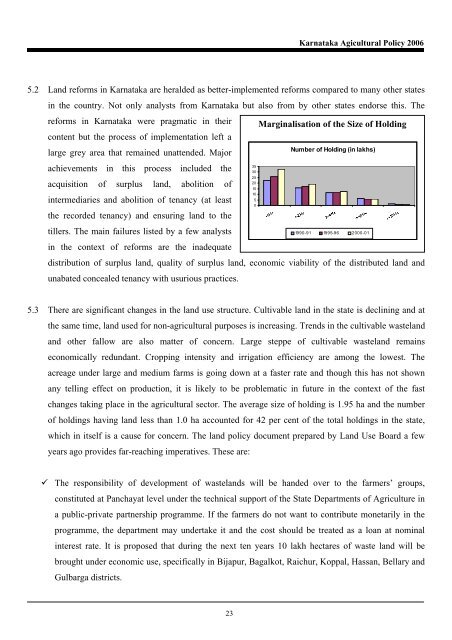Karnataka Agricultural Policy - Institute for Social and Economic ...
Karnataka Agricultural Policy - Institute for Social and Economic ...
Karnataka Agricultural Policy - Institute for Social and Economic ...
You also want an ePaper? Increase the reach of your titles
YUMPU automatically turns print PDFs into web optimized ePapers that Google loves.
<strong>Karnataka</strong> Agicultural <strong>Policy</strong> 2006<br />
5.2 L<strong>and</strong> re<strong>for</strong>ms in <strong>Karnataka</strong> are heralded as better-implemented re<strong>for</strong>ms compared to many other states<br />
in the country. Not only analysts from <strong>Karnataka</strong> but also from by other states endorse this. The<br />
re<strong>for</strong>ms in <strong>Karnataka</strong> were pragmatic in their<br />
content but the process of implementation left a<br />
large grey area that remained unattended. Major<br />
Marginalisation of the Size of Holding<br />
Number of Holding (in lakhs)<br />
achievements in this process included the<br />
acquisition of surplus l<strong>and</strong>, abolition of<br />
intermediaries <strong>and</strong> abolition of tenancy (at least<br />
the recorded tenancy) <strong>and</strong> ensuring l<strong>and</strong> to the<br />
35<br />
30<br />
25<br />
20<br />
15<br />
10<br />
5<br />
0<br />
tillers. The main failures listed by a few analysts<br />
19 9 0 - 9 1 19 9 5- 9 6 2000-01<br />
in the context of re<strong>for</strong>ms are the inadequate<br />
distribution of surplus l<strong>and</strong>, quality of surplus l<strong>and</strong>, economic viability of the distributed l<strong>and</strong> <strong>and</strong><br />
unabated concealed tenancy with usurious practices.<br />
5.3 There are significant changes in the l<strong>and</strong> use structure. Cultivable l<strong>and</strong> in the state is declining <strong>and</strong> at<br />
the same time, l<strong>and</strong> used <strong>for</strong> non-agricultural purposes is increasing. Trends in the cultivable wastel<strong>and</strong><br />
<strong>and</strong> other fallow are also matter of concern. Large steppe of cultivable wastel<strong>and</strong> remains<br />
economically redundant. Cropping intensity <strong>and</strong> irrigation efficiency are among the lowest. The<br />
acreage under large <strong>and</strong> medium farms is going down at a faster rate <strong>and</strong> though this has not shown<br />
any telling effect on production, it is likely to be problematic in future in the context of the fast<br />
changes taking place in the agricultural sector. The average size of holding is 1.95 ha <strong>and</strong> the number<br />
of holdings having l<strong>and</strong> less than 1.0 ha accounted <strong>for</strong> 42 per cent of the total holdings in the state,<br />
which in itself is a cause <strong>for</strong> concern. The l<strong>and</strong> policy document prepared by L<strong>and</strong> Use Board a few<br />
years ago provides far-reaching imperatives. These are:<br />
The responsibility of development of wastel<strong>and</strong>s will be h<strong>and</strong>ed over to the farmers’ groups,<br />
constituted at Panchayat level under the technical support of the State Departments of Agriculture in<br />
a public-private partnership programme. If the farmers do not want to contribute monetarily in the<br />
programme, the department may undertake it <strong>and</strong> the cost should be treated as a loan at nominal<br />
interest rate. It is proposed that during the next ten years 10 lakh hectares of waste l<strong>and</strong> will be<br />
brought under economic use, specifically in Bijapur, Bagalkot, Raichur, Koppal, Hassan, Bellary <strong>and</strong><br />
Gulbarga districts.<br />
23

















